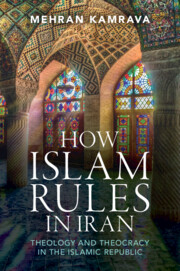485 results
7 - Iran and West Africa
- from Part II - Forming an Africa Policy (1971–1975)
-
- Book:
- Pahlavi Iran's Relations with Africa
- Print publication:
- 27 June 2024, pp 175-202
-
- Chapter
- Export citation
3 - ‘Creating Influence and Dialogue with the African Continent’ (1960–1968)
- from Part I - Establishing Relations (c. 1957–1970)
-
- Book:
- Pahlavi Iran's Relations with Africa
- Print publication:
- 27 June 2024, pp 65-93
-
- Chapter
- Export citation
4 - Establishing Ties with Apartheid South Africa
- from Part I - Establishing Relations (c. 1957–1970)
-
- Book:
- Pahlavi Iran's Relations with Africa
- Print publication:
- 27 June 2024, pp 94-116
-
- Chapter
- Export citation
3 - The Human Bombs of Twentieth-Century Shi’i Islam
-
- Book:
- Constructing Religious Martyrdom
- Print publication:
- 27 June 2024, pp 139-217
-
- Chapter
- Export citation
1 - Iran, Egypt and the Spectre of Nasserism
- from Part I - Establishing Relations (c. 1957–1970)
-
- Book:
- Pahlavi Iran's Relations with Africa
- Print publication:
- 27 June 2024, pp 19-40
-
- Chapter
- Export citation
3 - Stalin in Europe
- from Part I - Ambition
-
- Book:
- To Run the World
- Published online:
- 30 May 2024
- Print publication:
- 30 May 2024, pp 69-110
-
- Chapter
- Export citation
Chapter 28 - Iran
- from Part V - World Cultures Inspiration and Reception
-
-
- Book:
- Goethe in Context
- Published online:
- 16 May 2024
- Print publication:
- 23 May 2024, pp 272-281
-
- Chapter
- Export citation
9 - Whither the Islamic Republic?
-
- Book:
- How Islam Rules in Iran
- Published online:
- 02 May 2024
- Print publication:
- 09 May 2024, pp 297-304
-
- Chapter
- Export citation
1 - Introduction
-
- Book:
- How Islam Rules in Iran
- Published online:
- 02 May 2024
- Print publication:
- 09 May 2024, pp 1-10
-
- Chapter
-
- You have access
- HTML
- Export citation
8 - Perfect Strangers: Australia and West Asia
- from Part 2 - Relationships
-
-
- Book:
- Australia in World Affairs 2001–2005
- Published online:
- 04 May 2024, pp 128-144
-
- Chapter
- Export citation

How Islam Rules in Iran
- Theology and Theocracy in the Islamic Republic
-
- Published online:
- 02 May 2024
- Print publication:
- 09 May 2024
Timing bombs and the temporal dynamics of Iranian nuclear security
-
- Journal:
- European Journal of International Security , First View
- Published online by Cambridge University Press:
- 29 April 2024, pp. 1-19
-
- Article
-
- You have access
- Open access
- HTML
- Export citation
Geology, fluid inclusions and C−O−S−Pb isotopic compositions of the Chahmileh Pb-Zn deposit, Central Iran: Implications for ore genesis
-
- Journal:
- Geological Magazine / Volume 160 / Issue 11 / November 2023
- Published online by Cambridge University Press:
- 04 April 2024, pp. 1953-1974
-
- Article
-
- You have access
- Open access
- HTML
- Export citation
Chapter 6 - The Travel Book and Wounded Civilizations
-
- Book:
- V. S. Naipaul and World Literature
- Published online:
- 01 February 2024
- Print publication:
- 08 February 2024, pp 164-197
-
- Chapter
- Export citation
Conclusion
-
- Book:
- Netanyahu vs The Generals
- Published online:
- 11 January 2024
- Print publication:
- 18 January 2024, pp 178-190
-
- Chapter
- Export citation
4 - Extraterritoriality
-
- Book:
- The Russia Sanctions
- Published online:
- 14 December 2023
- Print publication:
- 21 December 2023, pp 40-52
-
- Chapter
- Export citation
Conclusion
-
- Book:
- Persianate Verse and the Poetics of Eastern Internationalism
- Published online:
- 14 December 2023
- Print publication:
- 21 December 2023, pp 197-202
-
- Chapter
- Export citation
3 - The Financial Sanctions and Impact on the Global Financial System
-
- Book:
- The Russia Sanctions
- Published online:
- 14 December 2023
- Print publication:
- 21 December 2023, pp 27-39
-
- Chapter
- Export citation
Chapter 2 - Canons
-
- Book:
- Persianate Verse and the Poetics of Eastern Internationalism
- Published online:
- 14 December 2023
- Print publication:
- 21 December 2023, pp 67-104
-
- Chapter
- Export citation



